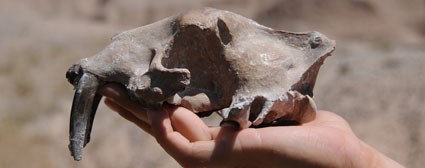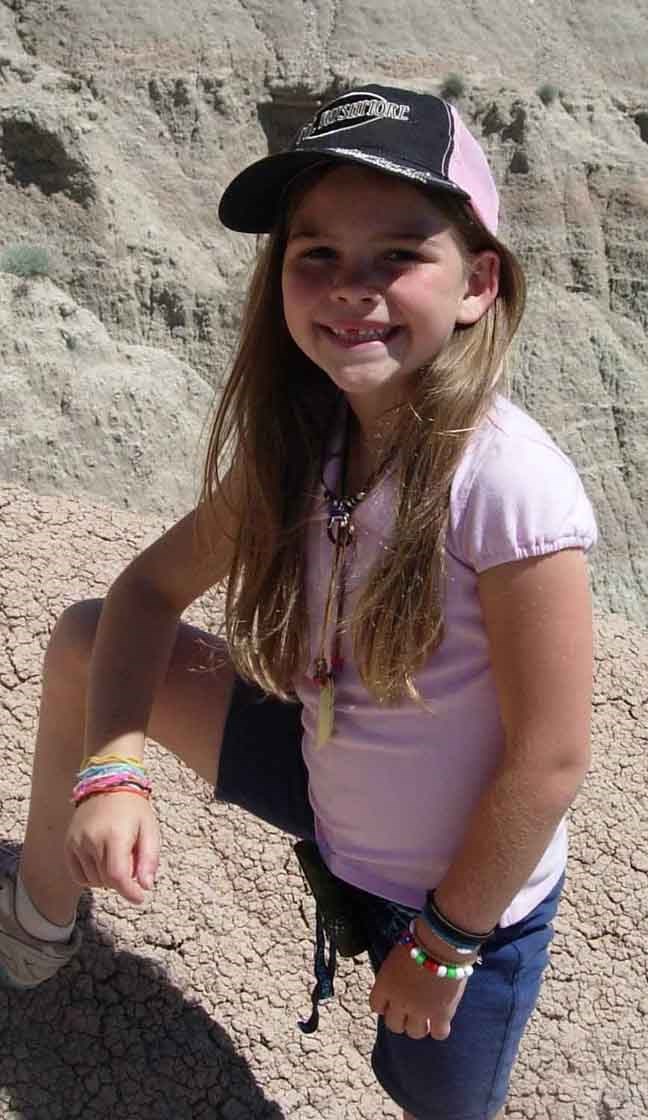Part of a series of articles titled Badlands Geology and Paleontology.
Article
Nimravid: Saber-toothed Hunter of the Badlands

NPS Photo

NPS Photo
Nimravid Facts
Although members of the carnivore family Nimravidae may have looked like cats, they're actually a separate family of creatures. Their short face suggests that they looked superficially like cats, but some important differences exist between the Nimravidae family and the Felidae family (to which modern cats belong). The braincase of Nimravidae is short, unlike a Felidae braincase, which is elongated. There are also differences in the completion of an auditory bulla (a hollow, rounded part of the skull which contains parts of the middle and inner ear). Modern cats also walk on their toes, whereas members of Nimravidae would have walked flat-footed, like a bear.
Members of the Nimravid family (like Hoplophoneus, Dinictus, and Pogonodon) all belonged to the order Carnivora. Animals belonging to the order Carnivora typically eat meat as food, and the animals who eat the most meat out of this order are often referred to as hypercarnivorous. Nimravidae were hypercarnivorous, eating almost entirely meat for their whole diet. Using their characteristic long, sharp teeth, Nimravidae would hunt for their food, and some (like Hoplophoneus) were likely solitary ambush predators. They were fairly large, ranging from the size of a mountain lion to that of a jaguar! This meant that their prey could be pretty large -- the most likely prey for Nimravids at this time ranged from sheep-sized oreodonts to small horses and small rhinocerotids.
While fossils often work together to tell us the story of an entire species, sometimes paleontologists come across unique finds which tell us about the life of an individual animal. The Hoplophoneus skull found by Kylie Ferguson in 2010 is one of them! On the left side of the skull, there are two puncture holes. One is in the eye socket and one is slightly further back on the skull, just behind the eye socket. Paleontologists studied these wounds and found that they showed no signs of healing, meaning that the animal died before these wounds could heal. Their most likely hypothesis for these punctures is that an animal attacked this Hoplophoneus, which died from these attack wounds. But what animal could possibly take on something as intimidating as a saber-toothed false-cat? Upon examination, paleontologists noticed that the distance between the bite marks on this specimen matches the distance between its own saber teeth -- this means that the attacker may have been another Hoplophoneus! Using information from fossil finds helps give us clues about the past, in this instance telling us that cats back then may have been like cats today, getting into catfights over things like food, mates, and territory.

NPS Photo
Kylie's Cat
In May of 2010, seven-year-old Kylie Ferguson, on vacation from Georgia, participated in a Junior Paleontologist program at Badlands National Park, South Dakota. Just a few hundred feet from the visitor center, Kylie discovered a rare, museum quality nimravid.
Like many familes on vacation, her sister Skylar, and their parents joined a Park Ranger in an outdoor activity. Taking a hike at Badlands National Park was one of the requirements for Kylie to earn a badge.
Following what she had learned from the Park Ranger and the Junior Ranger activity book, Kylie noticed something buried in a butte near the park's Ben Reifel Visitor Center. It was white, shiny, and they thought it was a fossil. Kyle was thrilled about her potential discovery, but she did not try to dig it out herself. Instead she returned to the visitor center and wrote up a detailed report that described her find and its exact location.
Last updated: November 10, 2020
